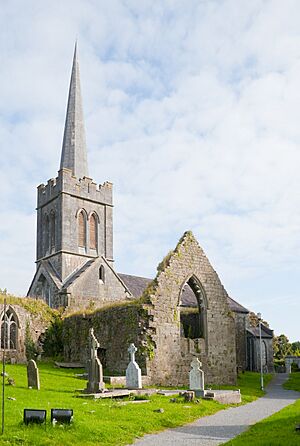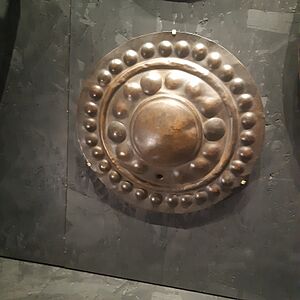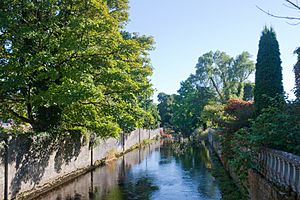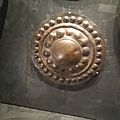Athenry facts for kids
Quick facts for kids
Athenry
Baile Átha an Rí
|
|
|---|---|
|
Town
|
|

|
|
| Country | Ireland |
| Province | Connacht |
| County | County Galway |
| Elevation | 47 m (154 ft) |
| Population | 4,603 |
| Time zone | UTC±0 (WET) |
| • Summer (DST) | UTC+1 (IST) |
| Eircode routing key |
H65
|
| Telephone area code | +353(0)91 |
| Irish Grid Reference | M500282 |
Athenry (pronounced ath-uhn-RYE) is a historic town in County Galway, Ireland. It is about 25 kilometers (15 miles) east of Galway city. Athenry is famous for its old medieval buildings. These include its strong town walls, Athenry Castle, an old priory, and its original 13th-century street layout. Many people also know the town because of the popular song "The Fields of Athenry".
Contents
What's the Story Behind Athenry's Name?
Athenry's name comes from an old Irish phrase, Áth na Ríogh. This means 'Ford of the Kings'. A 'ford' is a shallow place in a river where you can cross. This ford was on the River Clarin, just east of the town.
The area was once home to the Ó Mainnín family, who were kings of a place called Soghan. This is why it was known as the 'Ford of the Kings'. On some old maps made by English people, the town was even called Kingstown.
Exploring Athenry's Ancient History
Athenry has a long and interesting history, going back many centuries.
Who Built Athenry Castle?
The oldest building still standing in Athenry is Athenry Castle. It was built before 1240 by a person named Meyler de Bermingham. This castle was very important for protecting the town.
The Dominican Priory: A Place of Learning
In 1241, a Dominican Priory was started in Athenry. A priory is like a monastery where monks live and study. This priory became a very important place for learning and teaching in Ireland.
Later, during a time called the Protestant Reformation, the priory was supposed to close. But it managed to stay open for a while. Sadly, it was damaged and burned during wars in the 1500s. Then, in the 1650s, it was further destroyed by soldiers.
The Impressive Town Walls
The medieval walls around Athenry are some of the best and most complete in all of Ireland. About 70% of the original wall is still standing! You can also see some of the original towers and the North gate. Part of another old gate, the Lorro Gate, was found in 2007 during road work.
The Unique Market Cross
In the middle of Athenry, there is a place called the 'square'. For hundreds of years, markets were held here. The town's unique 'Market Cross' from the late 1400s is still there. This monument is special because it's the only one of its kind in Ireland. It's also the only medieval cross in the country that is still in its original spot.
St Mary's Collegiate Church
Next to the town square are the remains of St Mary's Collegiate Church, built in the mid-1200s. Most of the original church is gone. But in 1828, a new church was built inside its old walls. Today, a heritage center is located there.
A Glimpse into the Past: A Visitor's View
In 1791, a visitor named Jean Antoine Coquebert de Montbret wrote about Athenry. He said the town covered about 50 acres but only had around 60 houses. He mentioned the ruins of the abbey and the large, empty Bermingham's Court castle. He also saw the broken cross in the middle of town. He even noticed a cake with a bouquet at a tavern, which was a prize for the best dancer!
Moyode Castle and Ancient Discoveries
Moyode Castle is another old, tall castle from the 1500s. It's about 3.5 miles (5.6 km) from Athenry. This castle has been restored and people live in it today.
In 1863, an old shield from the late Bronze Age was found near Athenry. This shield is now kept in the British Museum in London.
How Do People Travel and Work in Athenry?
Athenry is a busy town with good connections and some interesting businesses.
Getting Around: Transport in Athenry
- By Road: The M6 motorway passes by Athenry. This road connects Galway city to Dublin, making it easy to travel.
- By Rail: Athenry has a train station that opened way back in 1851. It's on the main train line that goes from Galway to Dublin. Athenry is also a junction for another train line, the Western Railway Corridor, which is still being completed.
Working in Athenry: Local Industry
In 2017, plans were made for a "Food Innovation Hub" in Athenry. This project aims to create many new jobs, possibly around 360 within three years. It's a big step for the town's economy.
Sports and Fun in Athenry
Athenry is a very active town with many sports clubs for young people and adults.
Gaelic Games: Hurling Champions
Athenry is home to the Gaelic Athletic Association St. Mary Club. This club is famous for its hurling team. They have won the All-Ireland Senior Club Hurling Championship three times! Hurling is a fast-paced Irish sport played with sticks and a ball.
Running Fast: Olympic Sprinters
The Athenry Athletics Club has sections for both kids and adults. Two amazing sprinters from this club have even competed in the Olympic Games!
- Martina McCarthy ran in the women's 4 × 400 meters relay at the 2000 Summer Olympics.
- Paul Hession competed in the men's 200 meters at the 2008 Summer Olympics.
Football Success: Athenry F.C.
Athenry F.C. is the town's football (soccer) club, started in 1971. They have been very successful, reaching the final of the FAI Junior Cup in 2006. They also won the Galway & District League championship several times and the Connacht Junior Cup title many times.
Other Sports
Athenry also has an Athenry Golf Club for golf lovers and an Athenry Judo Club for those interested in martial arts.
Athenry Around the World: Twin Towns
Athenry has special connections with other towns in different countries. These are called "twin towns" or "sister cities".
- Athenry is twinned with Quimperlé in Brittany, France.
- Since 2013, it has also been twinned with Renews-Cappahayden in Newfoundland and Labrador, Canada.
Notable People from Athenry
Many interesting people have come from Athenry. Here are a few:
- Slim Barrett (born in the 1960s) – a jewellery designer and artist who has won awards.
- Noël Browne (1915–1997) – a doctor and politician.
- Ciarán Cannon (born 1965) – a politician who is a Teachta Dála (TD) for the Galway East area.
- Eugene Cloonan (born 1978) – a famous hurler.
- Paul Hession (born 1983) – an Olympic track and field athlete.
- Mary Lavin (1912–1996) – a well-known writer and novelist.
- P. J. Molloy (born 1952) – another famous hurler.
Images for kids
See also
 In Spanish: Athenry para niños
In Spanish: Athenry para niños











